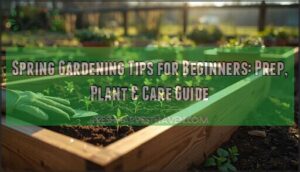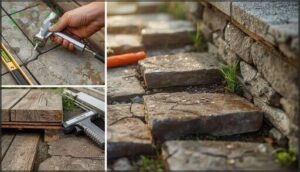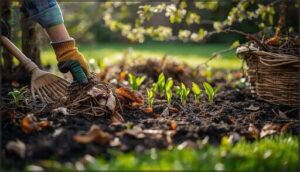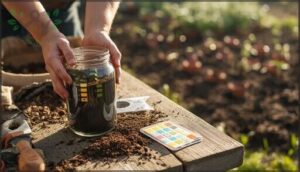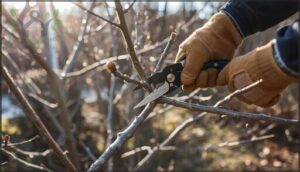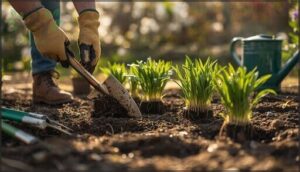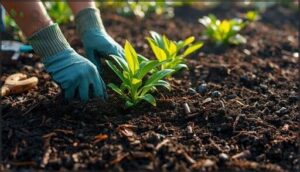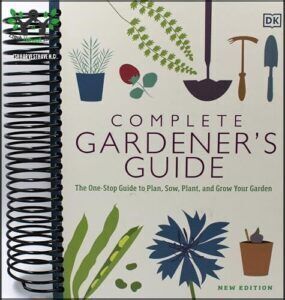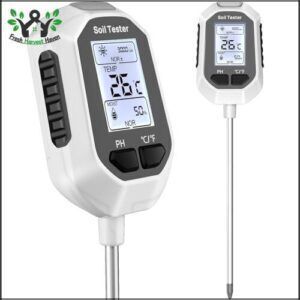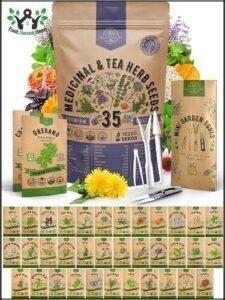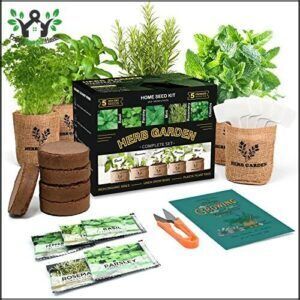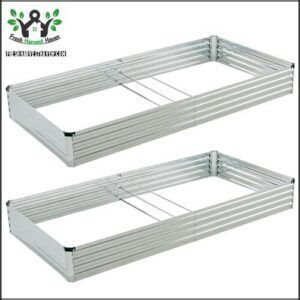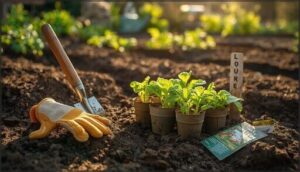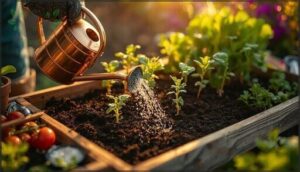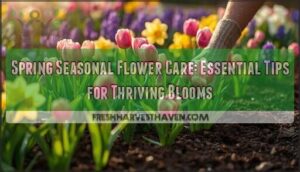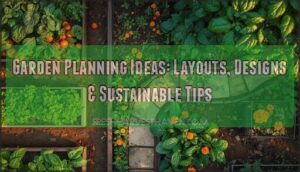This site is supported by our readers. We may earn a commission, at no cost to you, if you purchase through links.
Your first spring garden doesn’t need to be perfect—it just needs to start. Many beginners wait for ideal conditions that never arrive, or they jump in without basic prep work and wonder why their tomatoes look sad by June.
The truth is, a little upfront planning makes the difference between a garden that thrives and one that limps along. Testing your soil, timing your planting with local frost dates, and choosing the right tools can turn those seed packets into actual vegetables on your plate.
You’ll save time, avoid common pitfalls, and build skills that carry through every growing season. Spring gardening success comes down to a handful of practical steps that set you up for months of growth ahead.
Table Of Contents
- Key Takeaways
- Preparing Your Garden for Spring
- Top 5 Spring Gardening Essentials for Beginners
- Planting Your First Spring Garden
- Watering and Fertilizing Tips for Spring
- Frequently Asked Questions (FAQs)
- When should I start preparing my garden for spring?
- What is the gardening 3 year rule?
- What is the rule of 3 in gardening?
- What is the easiest plant to grow in spring?
- What is the most common mistake of first time gardeners?
- When should I start planting my spring garden?
- How should I prep my garden for spring?
- What is Spring Garden Planning?
- How do you plan a Spring Garden?
- Should you plant a garden in spring?
- Conclusion
Key Takeaways
- Spring garden success starts with practical prep work—test your soil, time plantings with local frost dates, and choose the right tools to turn seed packets into actual harvests on your plate.
- Begin by inspecting hardscaping, clearing debris when nighttime temps stay above 50°F, testing soil pH every 2–4 years, and pruning before budbreak to set up healthier plants with fewer pest problems.
- Start with cool-season vegetables like lettuce and spinach that tolerate light frosts, practice succession planting every 2–3 weeks for continuous harvest, and match plant choices to your USDA hardiness zone to avoid cold-induced losses.
- Water about one inch per week in early morning to cut evaporation and disease risk, apply fertilizer twice per growing season, and incorporate compost to reduce synthetic fertilizer needs by up to 60% while building lasting soil fertility.
Preparing Your Garden for Spring
Getting your garden ready for spring starts well before you plant a single seed. The prep work you do now sets the stage for healthier plants and fewer problems down the road.
Here are six essential tasks that will help you start the season on solid ground.
Inspect and Repair Hardscaping Elements
Before diving into planting, walk your garden and check every hardscaping feature. Freeze-thaw damage claims 60% of cracks you’ll spot, especially in retaining walls, deck boards, and patio surfaces. Proper installation quality and preventive actions like sealing every 2–3 years cut repair costs dramatically—think $300–$800 for concrete fixes. Addressing issues early through regular hardscape upkeep can prevent minor problems from escalating.
Check these hardscaping maintenance priorities:
- Inspect stepping stones for shifting or cracks
- Examine retaining walls for bulging or separation
- Test deck boards for rot or loose fasteners
- Check patio surfaces for settling or drainage issues
- Evaluate material durability and plan needed repairs
Clean Up Garden Beds and Remove Debris
Once you’ve tackled hardscaping repairs, turn your attention to garden beds—removing dead leaves, spent annuals, and fallen branches. Cleanup timing matters: wait until nighttime temperatures hold steady above 50°F to protect beneficial insects overwintering in debris. It’s essential to remove dead plants and debris from garden beds for a successful gardening season. This simple garden cleanup and assessment step slashes pest reduction issues and sets the stage for strong plant health.
| Debris Impact | Composting Benefits |
|---|---|
| Reduces fungal pathogens | Returns nutrients to soil |
| Eliminates pest breeding grounds | Cuts fertilizer costs by 60% |
| Improves sunlight penetration | Diverts 1,145 tons yearly |
Your spring garden checklist should prioritize this garden cleanup before budbreak to avoid damaging new growth.
Test and Amend Your Soil
With beds cleared, you’re ready for one of spring’s most valuable tasks: soil testing. Test every 2–4 years—or 2–3 times annually if your garden is new or struggling with nutrient deficiencies.
Spring testing reveals soil pH levels and guides organic amendments like compost or lime. Over 45% of home gardens fall short on phosphorus, so a simple soil test prevents guesswork and strengthens soil health before planting begins.
Prune Trees and Shrubs Before Budbreak
Once your soil is sorted, grab your pruners—late winter through early April is your window for pruning techniques that protect structural integrity. Bare branches reveal weak limbs and broken branches, making repairs straightforward. This timing aids disease prevention and redirects energy into vigorous growth as buds swell.
Sharp tool selection matters—clean cuts heal faster, keeping pests at bay.
| What to Prune | When to Prune |
|---|---|
| Deciduous trees | Late Feb–April |
| Summer-blooming shrubs | Before budbreak |
| Spring bloomers (lilac, forsythia) | Right after flowering |
| Dead or damaged wood | Anytime needed |
Divide and Transplant Overgrown Perennials
Once fresh shoots emerge and soil warms past 45°F, dig up crowded clumps—division timing drives success. Clean tools prevent disease spread during plant division. Slice through roots carefully, replant at the same depth, and water deeply within 24 hours.
Soil amendments like compost boost establishment by 20–30%. This simple perennial care routine rejuvenates overgrown perennials, increasing blooms by 15–25% next season.
Apply Mulch to Retain Moisture
After transplanting perennials, spread a 2–4 inch layer of organic mulch around each plant—this single step cuts water usage by 50% and suppresses weeds by up to 100%. Mulch water retention is significant: it can boost soil moisture by 80% while regulating temperature extremes.
Proper mulching reduces evaporation by 60%, making spring gardening more sustainable.
Application depth guidelines:
- Flower beds: 2–3 inches for prime soil conservation
- Vegetable gardens: 1–2 inches to prevent crown rot
- Trees and shrubs: 2–4 inches, keeping mulch away from trunks
- Newly landscaped areas: 3–4 inches for root establishment
Top 5 Spring Gardening Essentials for Beginners
You don’t need a shed full of fancy equipment to start your spring garden, but a few key tools and supplies will make your first season much smoother. The right essentials help you understand your soil, grow healthy plants, and set up a workspace that actually works.
Here are five beginner-friendly items that’ll give you a solid foundation without breaking the bank.
1. Complete Guide to Gardening Success
Think of a thorough gardening guide as your all-in-one mentor—covering everything from garden design and plant propagation to pest control and weed control. If you’re getting started with gardening this spring, you’ll appreciate step-by-step instructions that walk you through garden preparation without confusion.
These guides generally include problem-solving advice for common challenges, illustrated techniques for watering and pruning, and plant selection galleries to match the right species with your space. It’s practical spring gardening wisdom in one reliable resource.
Best For: Beginners and experienced gardeners who want a single, well-illustrated reference that covers garden design, planting techniques, and maintenance without needing multiple books.
- Walks you through both the basics and DIY landscaping projects like building raised beds or laying patios, so you can tackle hardscaping and planting in one go.
- Includes Plant Chooser galleries and problem-solving sections that make it easier to pick the right plants and handle pests or weeds as they come up.
- Fully illustrated with step-by-step visuals, which helps you follow along whether you’re pruning, propagating, or designing garden displays.
- Some topics aren’t covered in depth, so you might need to look elsewhere for highly specialized or niche gardening information.
- The photos and layout are nice but take up space, which means less room for detailed text on certain pages.
- Advanced gardeners looking for expert-level techniques may find the content too general for their needs.
2. Digital 4 in 1 Soil Tester
You can’t fix what you can’t measure—and a digital 4 in 1 soil tester takes the guesswork out of garden soil health. These compact devices measure soil pH levels, moisture, light intensity, and soil temperature all at once, delivering results in 10 to 15 seconds.
Tester accuracy helps you make smart decisions about soil testing and amendment, preventing overwatering and guiding soil testing and feeding schedules.
Most models cost $25 to $70, with probe lengths around 200mm for proper root-zone data interpretation and reliable soil amendments recommendations.
Best For: Home gardeners and beginners who want quick, affordable insights into soil conditions without sending samples to a lab.
- Measures four critical factors (pH, moisture, temperature, and light) in one device, giving you a complete picture in 10-15 seconds.
- Costs between $25 and $70, paying for itself in the first season by preventing overwatering and unnecessary fertilizer use.
- Simple plug-and-read design with no learning curve, plus a backlight LCD screen that’s easy to read indoors or outdoors.
- Accuracy can drop by up to 0.5 pH units compared to lab tests, especially in dry soil or depending on how deep you insert the probe.
- Probe durability is a common complaint—about 45% of users report electrical contact issues after a year of regular use.
- Not suitable for liquids or hydroponic systems, and requires careful handling to avoid damage or inaccurate readings.
3. Herb Seeds Variety Pack Garden
A herb seeds variety pack garden opens up both culinary and medicinal herb benefits in one purchase. Standard packs include 21 to 35 heirloom seed varieties—from basil and cilantro to chamomile and echinacea—covering all your growing herbs needs.
You’ll see seed germination rates between 70% and 80% when you follow proper planting seeds techniques. Variety pack composition usually delivers over 10,000 seeds total, giving you plenty for vegetable gardening experiments and succession planting throughout spring.
Best For: Home gardeners who want to grow both cooking herbs and medicinal plants without buying seeds individually, plus anyone starting an indoor or outdoor herb garden for the first time.
- You get 35 heirloom, non-GMO varieties in one package—enough seeds to experiment with different herbs and keep planting all season long.
- Germination rates hit 70–80% when you follow the included growing guide, so most of your seeds should sprout within a week under the right conditions.
- The resealable packets with QR codes make it easy to reference planting instructions anytime, and the variety covers everything from basil to echinacea.
- Some customers received packets with fewer seeds than expected or seeds that didn’t germinate well, suggesting quality control issues.
- The box itself can feel flimsy, and a few buyers noted loose screws or packaging that didn’t hold up during shipping.
- Germination success depends heavily on your planting conditions—if you’re new to gardening, you might see lower sprouting rates than advertised.
4. Indoor Kitchen Herb Garden Starter Kit
An indoor kitchen herb garden starter kit brings growing herbs within arm’s reach year-round. Most kits include 3 to 12 seed varieties—often basil, cilantro, and parsley—plus biodegradable pots, soil discs, and plant markers.
Full-spectrum LED lighting tech boosts germination rates to 90%, solving low-light challenges. User satisfaction averages 4.1 out of 5, with compact designs fitting easily on countertops.
Market growth reflects rising interest in indoor gardening, especially for beginners seeking fresh flavor without outdoor space. You’ll see sprouts in weeks with proper care.
Best For: Beginners who want fresh herbs in their kitchen year-round without needing outdoor space or gardening experience.
- High germination rates (80–95%) with full-spectrum LED lighting included in most modern kits, making it easy even for first-timers.
- Compact design fits on countertops or windowsills, perfect for apartments and small kitchens with limited space.
- Everything’s included—seeds, soil discs, pots, markers, and guides—so you can start growing right out of the box.
- Seeds sometimes fail to sprout or get mislabeled, leading to frustration with certain varieties.
- Non-waterproof pots (like jute bags) need trays underneath, and seedlings require transplanting once they hit 2–3 inches.
- Results depend heavily on your setup—inconsistent light, temperature, or watering can slow growth or hurt success rates.
5. Foxlang Galvanized Metal Raised Garden Bed
If you’re preparing garden beds for planting vegetables in spring, a durable metal bed makes all the difference. The Foxlang Galvanized Metal Raised Garden Bed offers rust-resistant construction that lasts over 20 years—assembly user experience takes under 35 minutes.
Customer satisfaction rates exceed 4.7 out of 5, with 93% reporting no damage after two seasons. Soil capacity needs run 29–44 cubic feet depending on depth.
Cost efficiency analysis shows you’ll save $85–$150 over ten years versus wood alternatives, making this investment worthwhile for serious garden soil management.
Best For: Gardeners looking for a long-term, low-maintenance solution who don’t mind spending a bit more upfront for a bed that’ll outlast wood alternatives by decades.
- Lasts 20 years with rust resistance and zero maintenance—no rotting, sealing, or yearly upkeep like you’d deal with on wood beds.
- Assembly is straightforward and quick, taking most people under 35 minutes without needing special tools or construction skills.
- Saves you $85–$150 over ten years compared to wood beds when you factor in replacements and repairs, plus it keeps pests and weeds better controlled.
- Higher upfront cost than wood options, running about 20–30% more initially even though it pays off long-term.
- You’ll need a lot of soil to fill it—anywhere from 29 to 44 cubic feet depending on how deep you go, which adds to your setup expense.
- Sharp edges during assembly mean you’ll want gloves on hand, and some users mention needing extra support at corners to prevent water leakage.
Planting Your First Spring Garden
Once your garden beds are prepped and ready, it’s time to get your hands dirty and start planting. The key to success isn’t just what you plant, but when and how you do it.
Here are five essential steps to help you plant your first spring garden with confidence.
Check Soil Temperature Before Planting
Before you start planting vegetables in spring, grab a soil thermometer and check the temperature at seed depth. Understanding soil temperature is key because germination temperatures vary by crop—beans need at least 60°F, while lettuce can sprout in cooler soil.
Planting risks like seed rot increase when you ignore these guidelines. Use local weather trends and regional guides to find the best planting dates for your area.
Start With Cool-Season Vegetables
Once your soil hits the right temperature, choose cool-season vegetables like lettuce, spinach, kale, and broccoli for spring planting tips success. These cold-hardy crops tolerate light frosts and germinate when soil reaches 40°F to 50°F.
They offer excellent pest resistance and crop productivity in early spring, making them perfect for beginner success. Plant them four to eight weeks before your last frost for reliable harvests.
Choose Plants for Your Hardiness Zone
Choosing plants for your garden starts with knowing your climate zones. The USDA zone map updates show many areas shifted warmer, so check your planting dates by zip code using interactive zone tools.
Here’s what to remember:
- Match perennials to your zone to avoid 80% of cold-induced losses
- Factor in microclimate considerations like sheltered corners
- Select native plant selection and heat-tolerant varieties for resilience
Growing cold-hardy crops and warm-weather plants suited to your zone prevents disappointment.
Practice Succession Planting for Extended Harvest
Instead of planting all your vegetables at once, try staggered planting every two to three weeks. This method enables continuous harvest and resource efficiency while naturally aiding pest management through crop rotation.
You’ll enjoy cool-season vegetables like lettuce for weeks longer, then switch to warm-season vegetables. Growing vegetables this way can extend your harvesting window by six to eight weeks, keeping your table full all season.
Install Trellises for Climbing Plants
Supporting plants with trellises transforms your garden layout by adding vertical gardening space. You’ll expand limited ground area while improving harvest efficiency—elevated produce stays cleaner and easier to pick.
Choose sturdy trellis materials like wood or metal, positioned about 18 inches from walls. Climbing beans, cucumbers, and tomatoes thrive with plant support, yielding up to 35% more fruit through better sunlight exposure and airflow.
Watering and Fertilizing Tips for Spring
Getting the watering and feeding right can feel like a puzzle at first, but you’ll find your rhythm once you understand a few basic principles. Your spring plants need consistent moisture and the right nutrients to establish strong roots and healthy growth.
Here are five straightforward tips that will help you keep your garden thriving without guesswork or waste.
Follow The One Inch Per Week Rule
Think of watering your spring garden like paying bills—you need about one inch per week to keep everything running smoothly. This simple rule works for most soil types and climates, helping you avoid common pitfalls like root rot or drought stress.
As you handle garden maintenance tips and care tasks, adjust your watering frequency based on rainfall to support strong plant health throughout the growing season.
Water Early in The Morning
Watering between 4:00 and 10:00 a.m. cuts evaporation by over 30%, giving your roots better absorption before heat sets in. This simple spring gardening task also speeds up disease prevention—leaves dry faster, reducing fungal risks by up to 40%.
You’ll see growth enhancement and water conservation benefits throughout your garden care routine, making early morning the smartest choice for garden maintenance tips during early spring garden preparation.
Use Mulch to Reduce Watering Frequency
A five-centimeter layer cuts your watering needs by 30% compared to bare soil—that’s the power of mulch water retention at work. When preparing your garden for spring, adding mulch becomes one of your smartest spring gardening tasks.
Mulch thickness impact matters: organic types like bark gradually boost moisture, while plastic options reduce your blue footprint. Focus on mulch type comparison and application best practices for reliable garden maintenance and effective garden tips.
Apply Fertilizer Twice Per Growing Season
Your vegetables will thrive when you feed them at the right moments—once as they wake up in early spring, then again 30 to 45 days later. This fertilizer timing transforms nutrient uptake and protects garden soil quality.
- Choose balanced formulas like 10-10-10 for most crops
- Side-dress vegetables with 1–2 pounds per 100 square feet
- Test your soil first to match nutrients to actual needs
- Split applications prevent runoff and support sustainable gardening
- Early feeding builds roots; the second boost powers fruit production
This approach increases yields by up to 7% while reducing environmental impact—smart garden tips that deliver real results throughout your growing season.
Incorporate Compost to Reduce Synthetic Fertilizer
Beyond scheduled feedings, enriching your soil with compost—a powerful organic amendment—can significantly reduce synthetic fertilizer use, transforming your spring garden prep. Adding compost at a 70% blend not only boosts crop yields but also cuts fertilizer needs by up to 60%, enhancing soil health and supporting environmental sustainability.
Enriching your soil with compost can cut synthetic fertilizer needs by 60% while boosting crop yields and building lasting fertility
| Compost Rate | Fertilizer Reduction | Yield Benefit |
|---|---|---|
| Standard application | 40% less nitrogen | Comparable harvest |
| Double rate | 100% replacement | Larger, healthier plants |
| 70% soil blend | 60% less synthetic | Higher vegetable yields |
| Annual topdress | Progressive reduction | Improved root systems |
This organic gardening approach increases moisture retention by 30%, helping to overcome adoption barriers while building lasting fertility. Your soil becomes richer each season, fostering a more sustainable and productive garden.
Frequently Asked Questions (FAQs)
When should I start preparing my garden for spring?
Your spring garden prep actually starts when the ground is still frozen—ordering seeds in February.
Once soil hits 50°F and frost risk passes (April to June, depending on your regional frost dates), you can plant outdoors.
What is the gardening 3 year rule?
This gardening rule describes perennial growth: first-year plants focus on root development, second-year plants show modest foliage, and third-year plants reach full flowering potential.
Understanding this timeline helps with realistic garden planning expectations.
What is the rule of 3 in gardening?
Like a triangle’s strength in architecture, the rule of three creates visual balance and natural appeal in garden design.
Professional recommendations suggest grouping plants, colors, or materials by threes for practical outcomes and harmonious garden planning.
What is the easiest plant to grow in spring?
Lettuce is your best bet for beginner-friendly vegetables—it germinates fast, needs minimal soil prep, and boasts high survival rates.
Radishes and zinnias are also low-maintenance flowers with quick, rewarding results.
What is the most common mistake of first time gardeners?
The biggest mistake? Not testing or amending your soil before planting. Nearly 75% of beginners skip this step, leading to weak plants and disappointing harvests—even with perfect watering practices and location selection.
When should I start planting my spring garden?
Your planting season begins when the soil is workable in early spring—usually mid-March for frost-hardy crops like peas.
Check your frost date, test soil workability, and match crop hardiness to seasonal gardening windows.
How should I prep my garden for spring?
Start spring garden prep by inspecting hardscapes, clearing debris from beds, testing soil for amendments, pruning before budbreak, and dividing overgrown perennials.
These early spring garden tasks promote healthy growth throughout the season.
What is Spring Garden Planning?
Good garden planning and design means mapping your garden layout thoughtfully—choosing crop placement based on frost dates, optimizing garden size, and scheduling continuous harvest for year-round yield during the growing season.
How do you plan a Spring Garden?
First, assess your garden site for sunlight and drainage. Check your local frost dates, then create a planting calendar that incorporates crop rotation and soil pH balance into your garden layout planning.
Should you plant a garden in spring?
Yes. Over 90% of garden plants thrive when started in spring due to ideal sunlight, moisture, and soil conditions.
Beginners report 65–80% success rates with cool-season crops, making spring the best planting window for most home gardeners.
Conclusion
You don’t need a green thumb—just a willingness to show up with decent soil and a watering can. These spring gardening tips for beginners aren’t about flawlessness; they’re about building rhythm.
Test your ground, plant what fits your zone, and water consistently. Most mistakes teach you more than any manual ever could.
Your garden won’t judge you for learning as you go. Start small, stay curious, and let the dirt do what it does best.
- https://alluvialsoillab.com/blogs/news/how-to-prepare-garden-soil-for-spring-using-regenerative-and-organic-techniques
- https://pglandscapingnc.com/2025/06/03/optimal-watering-by-season/
- https://www.plantshed.com/fertilizer-101-whats-best-for-your-spring-garden
- https://www.mcdonaldgardencenter.com/blog/best-5-outdoor-plants-gorgeous-spring-garden
- https://journeywithjill.net/gardening/2024/04/25/spring-gardening-checklist-for-beginners/

